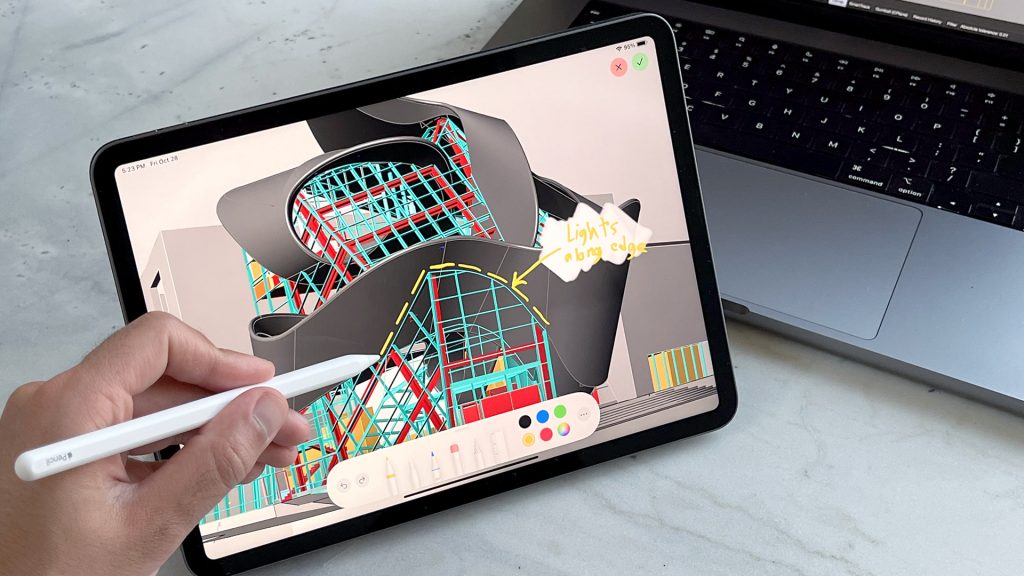In the AEC sector, McNeel Associates is a familiar and much-loved brand, along with its product Rhino. With a thriving ecosystem on Windows, Mac and in the cloud, the product has now gone mobile
The Apple iPad has been on a journey. It started life back in 2010 as a giant iPhone that didn’t make calls (unless they were via VoIP), but went on to finally cement a tablet market that had previously failed to attract many customers.
Today, with desktop-class Apple silicon, the iPad continues to provide portability, along with long battery life and pretty decent pen input.
We have already seen some great AEC application developments for the iPad, but historically, these have been mainly for the consumption of AEC data – via Autodesk BIM 360, Graphisoft BIMx and so on — rather than the creation of designs. If you go back to around 2010, you’ll find that iRhino 3D also started life as a navigator/viewer.
A lot has changed since then. Today’s reality is that the iPad is now powerful enough to run design-based desktop applications. One only has to look at Shapr3D, the excellent Spaces by Cerulean Labs (read our review) and SketchUp for iPad (read our review) to see how the iPad has become a viable laptop replacement for creatives.
The question is, will iRhino 3D remain a handy portable viewing and mark-up tool, or play a wider, more creative role in conceptual design?
This fact has not escaped McNeel Associates CEO Bob McNeel or the company’s lead on business development, Scott Davidson. In response, iRhino 3D has been relaunched with the full Rhino tech stack underneath and offering big possibilities. It requires the latest operating system, iOS 16. And, as it runs on an iPad, it obviously also runs on an iPhone, but you would have to be pretty desperate to do anything on such a small screen. For now, the 12.9-inch iPad would be ideal and there are rumours of an even bigger device in the works, with the possibility of a 16-inch model at some point in the future.
Rhino has not been ‘ported’ from the desktop. Instead, it was completely rewritten from the ground up and performs exactly like other versions, but with an interface that makes the most of a touch environment.
New horizons
Before readers get too excited, it’s important to stress that the initial version is intended for model viewing and mark-up only. But we have been assured by McNeel executives that, under the hood, the entire functionality of desktop Rhino is there already. Over time, that functionality will be exposed as the company finds out how users want to use the system and what new additions make sense in product development terms.
Apart from the power of the processor, Apple has with each generation of chip included more and more direct memory cache and expanded the addressable memory per application. This allows bigger programmes to run, working with bigger data sets. In other words, with each generation, the iPad is becoming increasingly usable for professional modelling use.
One of the original ‘melon twisters’ of the original iPad was its complete lack of a file system, or rather, its lack of exposing a file system to the user. This has been addressed over time, but even for long-time users, finding where the device stores files can sometimes be an absolute mystery. The safest option is to link the iPad to a cloud storage service. iRhino 3D supports iCloud, Dropbox, Google Drive, Box and other cloud storage providers. There’s a built-in file browser, too.
When models are loaded, they can be displayed in shaded, wireframe, rendered, ghost and X-Ray display modes. This is for all object types, breps, curves, meshes, point cloud, text and annotations. You can pan, zoom and orbit by dragging your fingers on the screen, providing instant and accurate control of the viewing position. The software supports any previously set up layouts (page views) and objects can be selected and queried for information.
There’s a built-in mark-up tool that works with the pen, which allows drawn highlights, text mark-ups, and some dimensioning. The software also supports an augmented reality (AR) mode.
Community feedback
In common with most McNeel products, iRhino is a work in progress and with the active user community, the company really listens to feature requests on its forums. Moreover, developers actually reply back to posts.
While it may not initially seem that iRhino 3D has made dramatic steps forward, the company has had to go back to the drawing board in order to support Apple silicon and the new Metal graphics. While that work was being done, adding in the Rhino engine for later exposure and usage made sense.
Now, the question is, will iRhino 3D remain a handy portable viewing and mark-up tool, or play a wider, more creative role in conceptual design? That, of course, will be down to users. I wonder how far away we are from Grasshopper running on an iPad?






